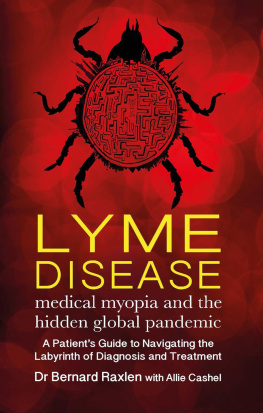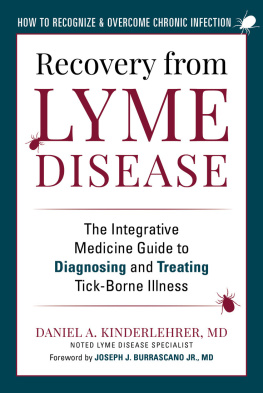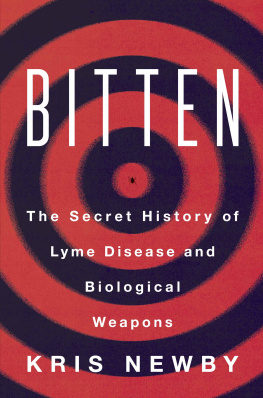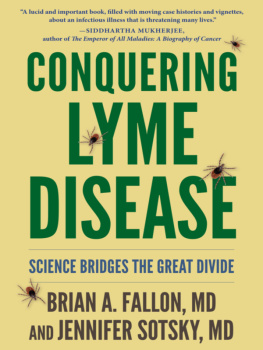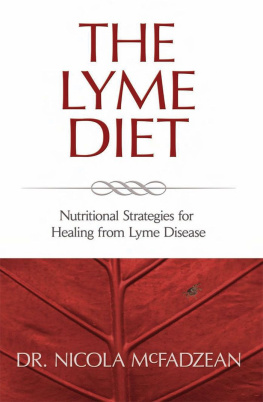Kenneth B. Singleton, M.D., M.P.H.
Foreword by James A. Duke, Ph.D. Author, The Green Pharmacy Brown Books Dallas, Texas The Lyme Disease Solution
2008 Kenneth B. Singleton, M.D., M.P.H.
All rights reserved. No part of this publication may be reproduced, stored in any retrieval system, or transmitted in any form or by any means, mechanical, photocopying, recording, or otherwise, without permission in writing from the publisher, except by a reviewer, who may quote brief passages in a review.
Manufactured in the United States of America
For information, please contact:
Brown Books Publishing Group 16200 North Dallas Parkway, Suite 170 Dallas, Texas 75248
www.brownbooks.com
972-381-0009
A New Era in Publishing
ISBN-13: 978-1-934812-00-6 ISBN-10: 1-934812-00-5 LCCN: 2007939144
1 2 3 4 5 6 7 8 9 10
This book is intended for educational purposes only. All information and advice contained herein is based on the authors personal and professional experience. This book exclusively
represents the viewpoint and approach of the author, and does not necessarily represent the viewpoint or approach of any other health care practitioner or organization of health care
practitioners. Before embarking on any advice given in the book, the reader is advised to consult their health care provider.
Dedication
This book is dedicated to all my Lyme and tick-borne infection patients who have taught me so much over the years. I also dedicate this book to the true pioneersthe two best Lyme doctors that I knowCharles Ray Jones, M.D., and Joseph Burrascano, M.D.the real heroes of the story.
Contents
Acknowledgmentsxi A Garden Parablexiii ForewordJames A. Duke, Ph.D.xvii Introductionxxi
Part One: The Lyme Disease Basics
1. Lyme Disease:
The Facts, Risks, Controversy, and Prevention3
What Is Lyme Disease? 4
The Prevalence of Lyme Disease 10
The Medical Controversy Surrounding Lyme Disease 15
The Lyme-Aware Doctors 21
PreventionThe Most Effective Method
for Dealing with Lyme Disease 242 Signs and Symptoms ofLyme Disease and Related Co-infections47
Symptoms of Lyme Disease 49
Dr Burrascanos Symptom Checklist for Lyme Disease 63
Co-infections and Lyme Disease 66
3. Effectively DiagnosingLyme and Its Co-infections87 Diagnosing Lyme Disease 88 Diagnosing the Co-infections 112
Part Two: Foundations of Lyme Treatment
4. Lyme Disease and Your Immune System131
A Balance of Opposites 132
Immune System Basics 136
Strategies for Immune System Enhancement and Regulation 150
5. The Lyme Inflammation Diet175
Understanding Inflammation 176
Chronic Inflammation and Lyme Disease 190
Adopting the Lyme Inflammation Diet 195
Phase One ......................... 198
Phase Two ......................... 206
Phase Three ......................... 211
Phase Four ......................... 217
6. Core Treatment Strategies for Lyme Disease and Other Tick-borne Diseases233
Beginning TreatmentMaking the Diagnosis 234
The First Core Component of Lyme Therapy: Antibiotics 239
The Second Core Component of Lyme Therapy: Basic
Lifestyle Health Principles and Nutritional Supplementation 259 The Third Core Component of Lyme Therapy:
Supportive Complementary and Alternative Therapies 282
Part Three: Problem-Specific Lyme Treatment Strategies
7. The Unhealthy Lyme P.I.E.E.291
Pain 292
Inflammation 302
Endocrine Hormonal Disruption 317
Energy Depletion and Fatigue 330
8. Improving Your Lyme G.L.A.N.D.S.343 Gastrointestinal Tract Function and Related
Gastrointestinal Problems 344
Liver Health 353
Anxiety and Depression 359
Neurological Function and Related Problems 371
Detoxification 391
Sleep and Sleep-Related Problems 400
9. Keeping Hope Alive: Psychological andSpiritual Considerations for Lyme Disease415
Appreciation 420 Higher Power 423 Optimism 424 Prayer and Positive Vision 428 Eating Properly 430 Forgiveness 431 Oxygen/Breathing 433 Relationships 434 Humor 436 Enjoy Today 438 Alternative Resources 440 Light 440 Trust 442 Helping Others 445
Conclusion449
Resources453
References467
Appendix: Lyme Inflammation Diet Sample Recipes479
Index499
About the Author523
Acknowledgments
Special Thanks To:
Ursuline Singleton, M.P.H., R.D.For your patience and diligence in reviewing the manuscript of this book, for your kind and gentle spirit, and for believing in me.James A. Duke, Ph.D.
For your incredible knowledge and expertise, for your meticulous review and wonderful suggestions, and for being the great teacher that you are.
Mark Garzon, M.D.For your special contribution to this book in the areas of Endocrinology and Toxicology, for which I am very grateful.Larry Trivieri, Jr.For your creativity and your superb writing and editing skills, without which this book would not have been possible. and
Those Who Took the Time to Review and Offer Excellent FeedbackDr. Kenneth Liegner, Dr. Binyamin Rothstein, Pastor Kevin McGhee, Mrs. Wendy Goodness.
xi
Special Thanks Also To Others Who Contributed Greatly:
Kathy Norris, Judy Madore, Lori Martell, Marcus Singleton, Myah Singleton, Ursula Beal, Alvin and Gloria Singleton, Marilyn Dimas, Dwight Singleton,Tami Lawyer, Brian Lawyer, Leya Schiller, Pam Andrews, Jean Galbreath, Dr. Brian Heaton, Dr. Mark McClure, and, most importantly, our Creator who makes all things possible.
xii
A Garden Parable
One spring day George decided to plant a garden. He went to the local nursery and bought several beautiful plants. After clearing the land, he put the plants in the ground.
For the first few months, his Garden was magnificent. The colors were spectacular. His neighbors would often slow down as they drove by his home to admire the beautiful Garden that George had created. In fact, George could hardly wait to get home from work every day so he could bask in the lush beauty of his new Garden.
But later in the season, some strange things began to happen in his Garden. He noticed several different varieties of weeds growing where none had ever grown before. He also noted that several of the plants had a peculiar fungus-like material on the leaves and stems. He further observed that some of the trees had insects burrowing under their bark and that the leaves were looking unhealthy.
George nervously ran down to the garden shop where he had bought the plants and bought the best herbicide, fungicide, and insecticide that he could find. Only the best would do for his wonderful Garden. He rushed home and sprayed and sprayed and sprayed.
xiii
And for a short time,it seemed that the chemicals workedthe weeds withered, the fungus lightened up, and the insects seemed to go away. But Georges elation turned into frustration a few weeks later, when all the problems returned with a vengeance.
In desperation, George asked his neighbor a few doors away for advice. (This neighbor, Kathy, also had a very nice garden, which seemed to be doing well.) Kathy told him that she had had similar problems for the first year of her garden. She had finally gotten advice from an old retired gardener named Frank. And that advice had made all the difference.


